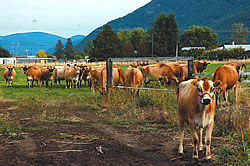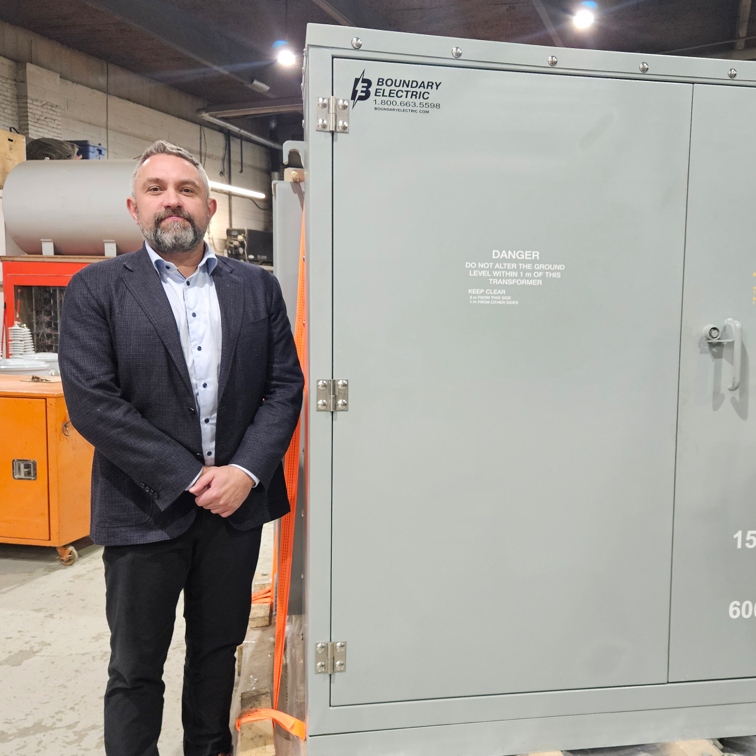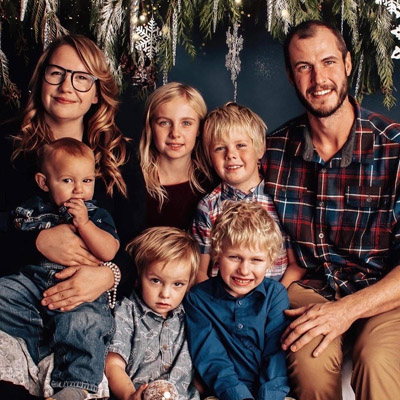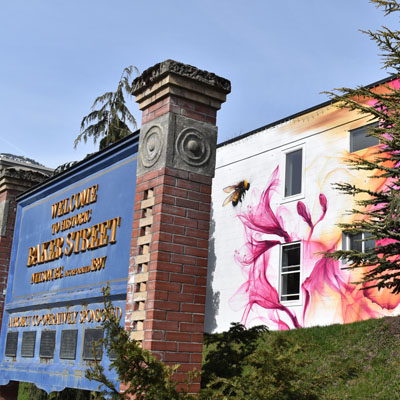The valley of plenty
Agriculture and food production is becoming a more important part of Grand Forks’ economy and business development plans

Grand Forks has more resources to sustain its economy — Tanya Laing Gahr photo
In a time of economic upheaval and uncertainty, the B.C. government is promising to do everything it can to recession-proof the provincial economy. Even so, many communities that have already felt the tremendous impact of a downward turn in the forestry sector are preparing to take on the upcoming storm.
At such a time, thoughts turn to looking after our most basic needs, including the question of food. In this regard, farmers and members of the business development community in the Kootenay Boundary region are taking some comfort in being the valley that can feed itself, thanks to an agricultural industry that has experienced tremendous growth in recent years.
“Agriculture has a long history in this valley,” said Jennifer Wetmore, the economic development co-ordinator with the Community Futures Boundary office based in Grand Forks. “We’re well built for agriculture. I think in the last 40 to 50 years, we’ve turned to a more resource-based industry. Since that’s fallen apart in the last few years, we’ve experienced high unemployment—big job losses—and it pushes you into a corner and forces you to look at what your other options are, and agriculture is an obvious one.”
Going back to their roots
Sheila Dobie is the owner of Spencer Hill Orchard and Gallery and a founding member of the Grand Forks and Boundary Regional Agricultural Society, a non-profit organization that promotes awareness and issues of regional farmers. The agricultural society has been working to make farming a more feasible business in the valley—a tall order in a sector dominated by industrial farms and a culture that seems to assume that food comes from the supermarket.
“We want to see the increased viability of small farms,” said Dobie. “Fundamentally, that’s why we’re there. We are all small farms and we want to ensure our own sustainability (through) market development, product development, regulatory concerns and working within those regulations to make sure we get the necessary infrastructure. Whatever it takes, we want to see the small farms stay.”
Ensuring that sustainability is a challenge that is being met on many fronts. Dobie said one of the society’s members is putting together a project that will bring farming to local school curriculums, for example, and educate students that the roots of their community lie in agriculture.
Homegrown meals
Giving local meat producers a means of being competitive in the community is on the plate of the agricultural society.
One of the main goals of the society at this point is the establishment of a mobile abattoir. The society is currently putting together a business plan that reflects supporting not only the small meat producers but the regional growers as a whole.
“I think the biggest issues right now … are the meat regulations and us wanting to ensure that it’s still sustainable for small farms to be operating,” said Dobie. “The small meat producer is essentially being regulated out of business. So we’re really working hard to create some infrastructure locally with a mobile abattoir and a distribution storefront concept where we have a way to process and distribute local food. We’re not only thinking of meat, we’re thinking of fruits and vegetables and value-added (products). So this business that this abattoir would be (part of) is a whole local food distribution network.”
The concept is finding support among the farmers in the area, who—as small producers—must be flexible in order to survive in an industry that can be highly competitive and underappreciated by local buyers. Jeremy DeVries, owner of Jerseyland Organics, said the agricultural society is providing a voice for the farming community within the Grand Forks region.
“The whole focus is to develop a regional food system and it’s a fantastic idea,” he said. “They’re trying to let people know what’s out there—which people have which farms have which products. They’re doing an excellent job and we want to be a part of it because of that. “I really believe in it and I think it’s going to be the way of the future, especially with the direction fuel is going. I think it will put us in a good position for the future.”
Jerseyland Organics—B.C.’s first certified organic dairy farm—has had success marketing its products well beyond the local region, including markets in the U.S. and as far east as Toronto, but DeVries believes that supporting local customers—who in turn support local farmers—should be the first priority.
“It seems silly: there are dairy farms in Creston whose milk goes all the way down to Burnaby and then back up from Burnaby to Creston and then everywhere,” said DeVries. “The freight is astronomical—where that milk is coming from, where the feed is coming from—it’s just not a sustainable agricultural system.”
Planting seeds of awareness
Wetmore believes one of the most exciting aspects of the agricultural society is that it is a true grassroots movement, created, she said, “literally from the ground up.”
As such, there is a level of comfort for the region as the economy seems to be winding down for a financial winter.
“I was at a sustainable meeting and I heard the phrase ‘the valley that can feed itself,’ and that’s something that we keep seeing pop up,” she said.
Dobie agreed that the image could resonate with people in the valley.
“If the whole valley rallied around that concept, there would be enormous benefits for every walk of life,” said Dobie, “not only the whole concept of how people think about their homeland but even people visiting and coming to this area. You can imagine the impact that concept would have.”
DeVries said the possibilities for the region lie just beneath the surface.
“People are moving here because there are agricultural possibilities here, and I think there’s a future in it,” he said. “It’s behind in other areas as far as support systems for farmers is concerned—everything is trucked in and trucked out, whereas in other farming areas everything is made right there.”
So increasing the support for the farmers locally means raising awareness.
“I think this is a real rural community and there are a lot of people who, if they aren’t farmers, rub shoulders with farmers on a fairly frequent basis,” said Dobie. “So they may have some sort of an inkling that Joe down the road who was a chicken farmer isn’t doing chicken meat anymore because of regulations, and oh, gee, isn’t that too bad … But people are starting to ask more questions about the source of their food and why can’t we get local chickens and then, hey, that project happened over there and why can’t that happen with Joe? So they are starting to ask those sorts of questions.”





Comments